Fluorine-Terminated Polycrystalline Diamond Solution-Gate Field-Effect Transistor Sensor with Smaller Amount of Unexpectedly Generated Fluorocarbon Film Fabricated by Fluorine Gas Treatment
Abstract
:1. Introduction
2. Materials and Methods
2.1. Fabrication of C–F Diamonds
2.2. Characterization of C–F Diamond Surface and Diamond SGFET
3. Results
3.1. Characterization of the C–F Diamond
3.2. Characterization of C–F BDD SGFET
4. Conclusions
Author Contributions
Funding
Institutional Review Board Statement
Informed Consent Statement
Data Availability Statement
Acknowledgments
Conflicts of Interest
References
- Tinwala, H.; Wairkar, S. Production, surface modification and biomedical applications of nanodiamonds: A sparkling tool for theranostic. Mater. Sci. Eng. C 2019, 97, 913–931. [Google Scholar] [CrossRef] [PubMed]
- Kondo, T.; Ito, H.; Kusakabe, K.; Ohkawa, K.; Einaga, Y.; Fujishima, A.; Kawai, T. Plasma etching treatment for surface modification of boron-doped diamond electrodes. Electrochim. Acta. 2007, 52, 3841–3848. [Google Scholar] [CrossRef]
- Shiomi, H. Surface damages in diamond by Ar/O2 plasma and their effect on the electrical and electrochemical characteristics of boron-doped layers. Jpn. J. Appl. Phys. 1997, 36, 7745. [Google Scholar] [CrossRef]
- Yagi, K.; Tsunozaki, D.; Tryk, A.; Fujishima, A. Control of the Dynamics of Photogenerated Carriers at the Boron-Doped Diamond/Electrolyte Interface by Variation of the Surface Termination. Electrochem. Solid-State Lett. 1999, 2, 457–460. [Google Scholar] [CrossRef]
- Baumann, P.K.; Nemanich, R.J. Surface cleaning, electronic states and electron affinity of diamond (100), (111) and (110) surfaces. Surf. Sci. 1998, 409, 320–335. [Google Scholar] [CrossRef]
- Ramesham, R. Effect of annealing and hydrogen plasma treatment on the voltammetric and impedance behavior of the diamond electrode. Thin Solid Films 1998, 315, 222–228. [Google Scholar] [CrossRef]
- Bobrov, K.; Mayne, A.; Comtet, G.; Dujardin, G.; Hellner, L.; Hoffman, A. Atomic-scale visualization and surface electronic structure of the hydrogenated diamond C(100)-(2x1):H surface. Phys. Rev. B 2003, 68, 195416. [Google Scholar] [CrossRef]
- Kondo, T.; Ito, H.; Kusakabe, K.; Ohkawa, K.; Honda, K.; Einaga, Y.; Fujishima, A.; Kawai, T. Characterization and electrochemical properties of CF4 plasma-treated boron-doped diamond surfaces. Diam. Relat. Mater. 2008, 17, 48–54. [Google Scholar] [CrossRef]
- Martin, H.B.; Argoitia, A.; Angus, J.C.; Landau, U. Voltammetry Studies of Single-Crystal and Polycrystalline Diamond Electrodes. J. Electrochem. Soc. 1999, 146, 2959–2964. [Google Scholar] [CrossRef]
- Durrant, S.F.; Peterlevitz, A.C.; Castro, S.G.; Landers, R.; Bica de Moraes, M.A. Characterization of diamond fluorinated by glow discharge plasma treatment. Diam. Relat. Mater. 2001, 10, 490–495. [Google Scholar] [CrossRef]
- Ferro, S.; Battisti, A.D. The 5-V Window of Polarizability of Fluorinated Diamond Electrodes in Aqueous Solutions. Anal. Chem. 2003, 75, 7040–7042. [Google Scholar] [CrossRef] [PubMed]
- Shintani, Y.; Kobayashi, M.; Kawarada, H. An All-Solid-State pH Sensor Employing Fluorine-Terminated Polycrystalline Boron-Doped Diamond as a pH-Insensitive Solution-Gate Field-Effect Transistor. Sensors 2017, 17, 1040. [Google Scholar] [CrossRef] [PubMed]
- Ferro, S.; Battisti, A.D. Physicochemical Properties of Fluorinated Diamond Electrodes. J. Phys. Chem. B 2003, 107, 7567–7573. [Google Scholar] [CrossRef]
- Luo, D.; Ma, D.; Liu, S.; Nakata, K.; Fujishima, A.; Wu, L. Electrochemical reduction of CO2 on fluorine-modified boron-doped diamond electrode. Diam. Relat. Mater. 2022, 121, 108753. [Google Scholar] [CrossRef]
- Siné, G.; Ouattara, L.; Panizza, M.; Comninellis, C. Electrochemical Behavior of Fluorinated Boron-Doped Diamond. Electrochem. Solid-State Lett. 2003, 6, D9–D11. [Google Scholar] [CrossRef]
- Kawarada, H.; Araki, Y.; Sakai, T.; Ogawa, T.; Umezawa, H. Electrolyte-Solution-Gate FETs Using Diamond Surface for Biocompatible Ion Sensors. Phys. Status Solidi. 2001, 185, 79–83. [Google Scholar] [CrossRef]
- Edgington, R.; Ruslinda, A.R.; Sato, S.; Ishiyama, Y.; Tsuge, K.; Ono, T.; Kawarada, H.; Jackman, R.B. Boron δ-doped (111) diamond solution gate field effect transistors. Biosens. Bioelectron. 2012, 33, 152–157. [Google Scholar] [CrossRef] [Green Version]
- Edgington, R.; Sato, S.; Ishiyama, Y.; Morris, R.; Jackman, R.B.; Kawarada, H. Growth and electrical characterisation of δ-doped boron layers on (111) diamond surfaces. J. Appl. Phys. 2012, 111, 033710. [Google Scholar] [CrossRef]
- Sasaki, Y.; Kawarada, H. Low drift and small hysteresis characteristics of diamond electrolyte-solution-gate FET. J. Phys. D Appl. Phys. 2010, 43, 374020. [Google Scholar] [CrossRef]
- Shintani, Y.; Ibori, S.; Igarashi, K.; Naramura, T.; Inaba, M.; Kawarada, H. Polycrystalline boron-doped diamond with an oxygen-terminated surface channel as an electrolyte-solution-gate field-effect transistor for pH sensing. Electrochim. Acta 2016, 212, 10–15. [Google Scholar] [CrossRef]
- Shintani, Y.; Ibori, S.; Kawarada, H. Deoxyribonucleic-acid-sensitive Polycrystalline Diamond Solution-gate Field-effect Transistor with a Carboxyl-terminated Boron-doped Channel. Anal. Sci. 2019, 35, 923–927. [Google Scholar] [CrossRef] [PubMed] [Green Version]
- Falina, S.; Kawai, S.; Oi, N.; Yamano, H.; Kageura, T.; Suaebah, E.; Inaba, M.; Shintani, Y.; Syamsul, M.; Kawarada, H. Role of Carboxyl and Amine Termination on a Boron-Doped Diamond Solution Gate Field Effect Transistor (SGFET) for pH Sensing. Sensors 2018, 18, 2178. [Google Scholar] [CrossRef] [PubMed] [Green Version]
- Rietwyk, K.J.; Wong, S.L.; Cao, L.; O’Donnell, K.M.; Ley, L.; Wee, A.T.S.; Pakes, C.I. Work function and electron affinity of the fluorine-terminated (100) diamond surface. Appl. Phys. Lett. 2013, 102, 091604. [Google Scholar] [CrossRef] [Green Version]
- Foord, J.S.; Singh, N.K.; Jackman, R.B.; Gutierrez-Sosa, A.; Proffitt, S.; Holt, K.B. Reactions of xenon difluoride and atomic hydrogen at chemical vapour deposited diamond surfaces. Surf. Sci. 2001, 488, 335–345. [Google Scholar] [CrossRef]
- Syamsul, M.; Kitabayashi, Y.; Matsumura, D.; Saito, T.; Shintani, Y.; Kawarada, H. High voltage breakdown (1.8 kV) of hydrogenated black diamond field effect transistor. Appl. Phys. Lett. 2016, 109, 203504. [Google Scholar] [CrossRef]
- Shintani, Y.; Kawarada, H. Polycrystalline Boron-doped diamond electrolyte-solution-gate field-effect transistor for an ap-plication to the measurement of water percentage in ethanol. Anal. Sci. 2017, 33, 1193–1196. [Google Scholar] [CrossRef] [Green Version]
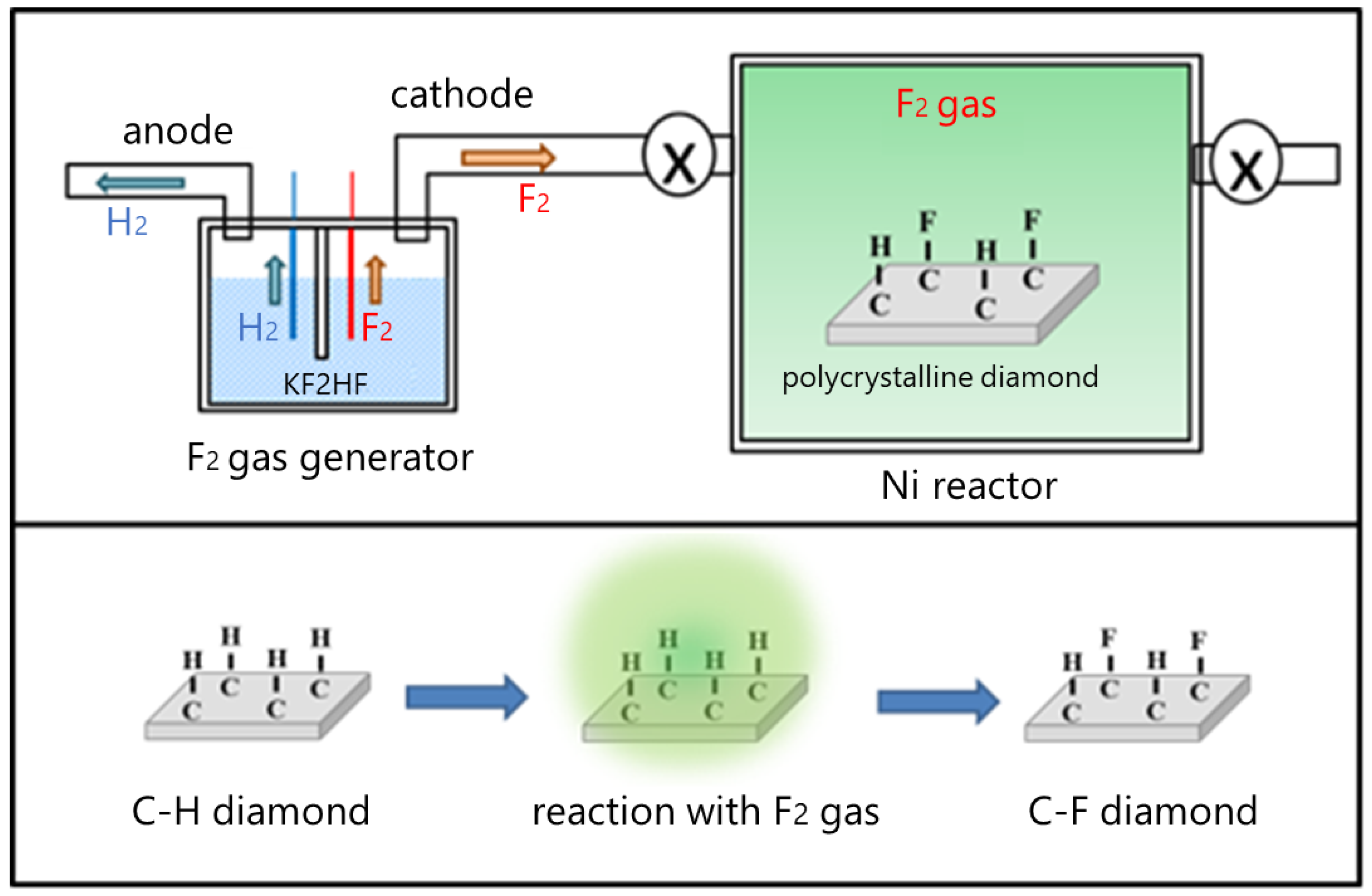
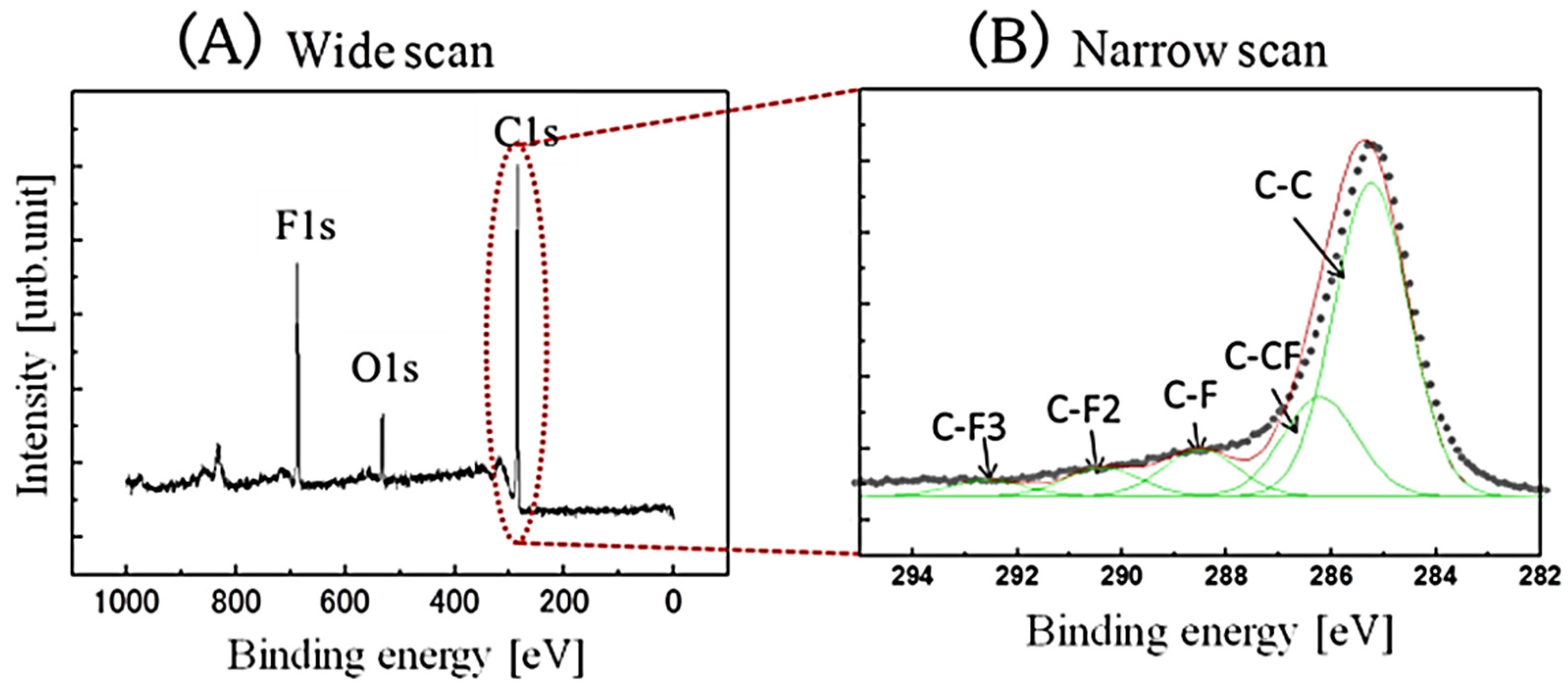
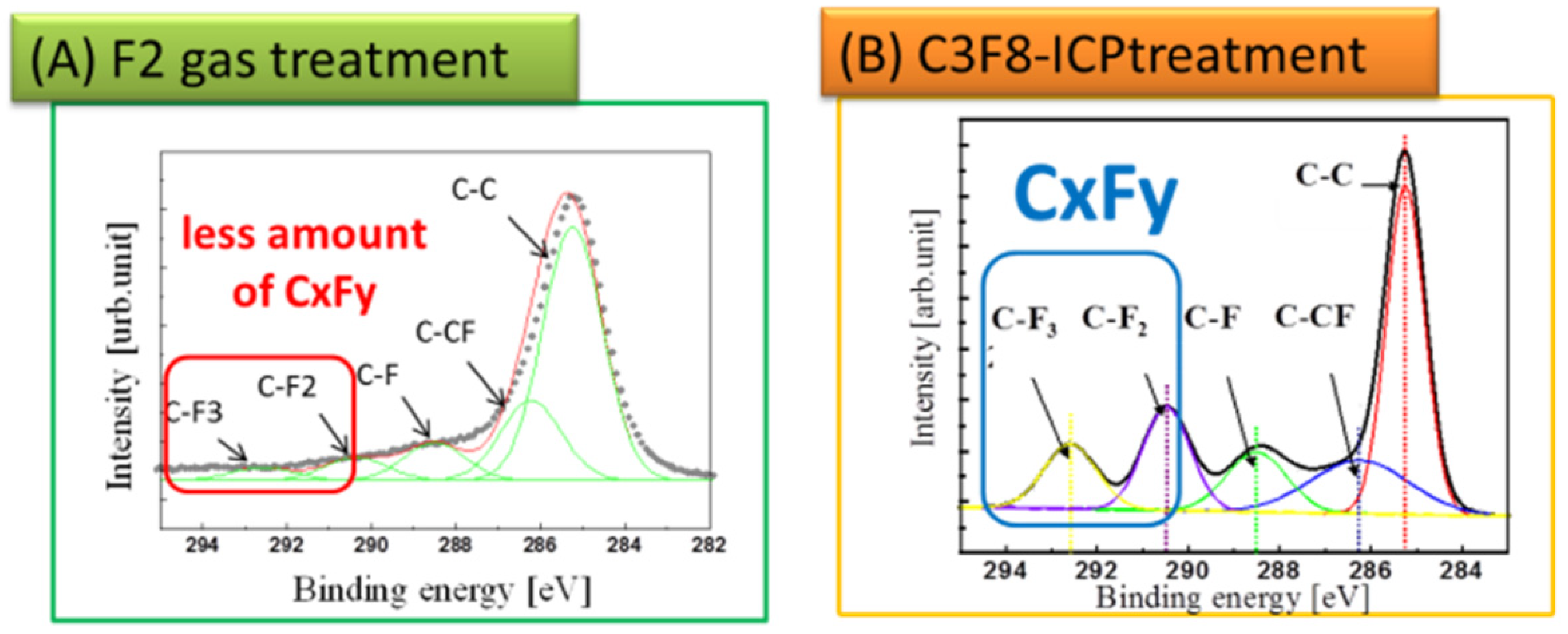

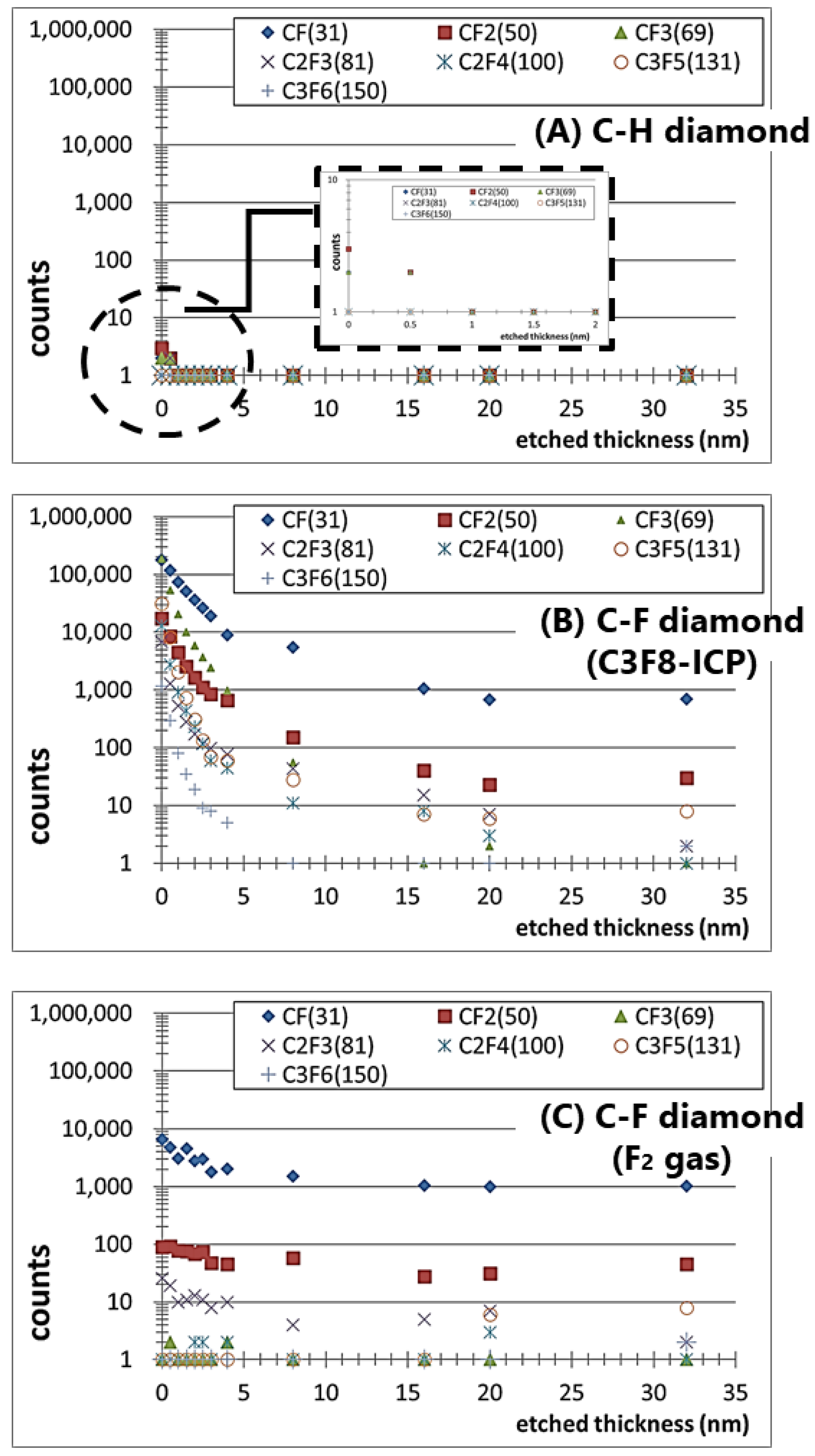
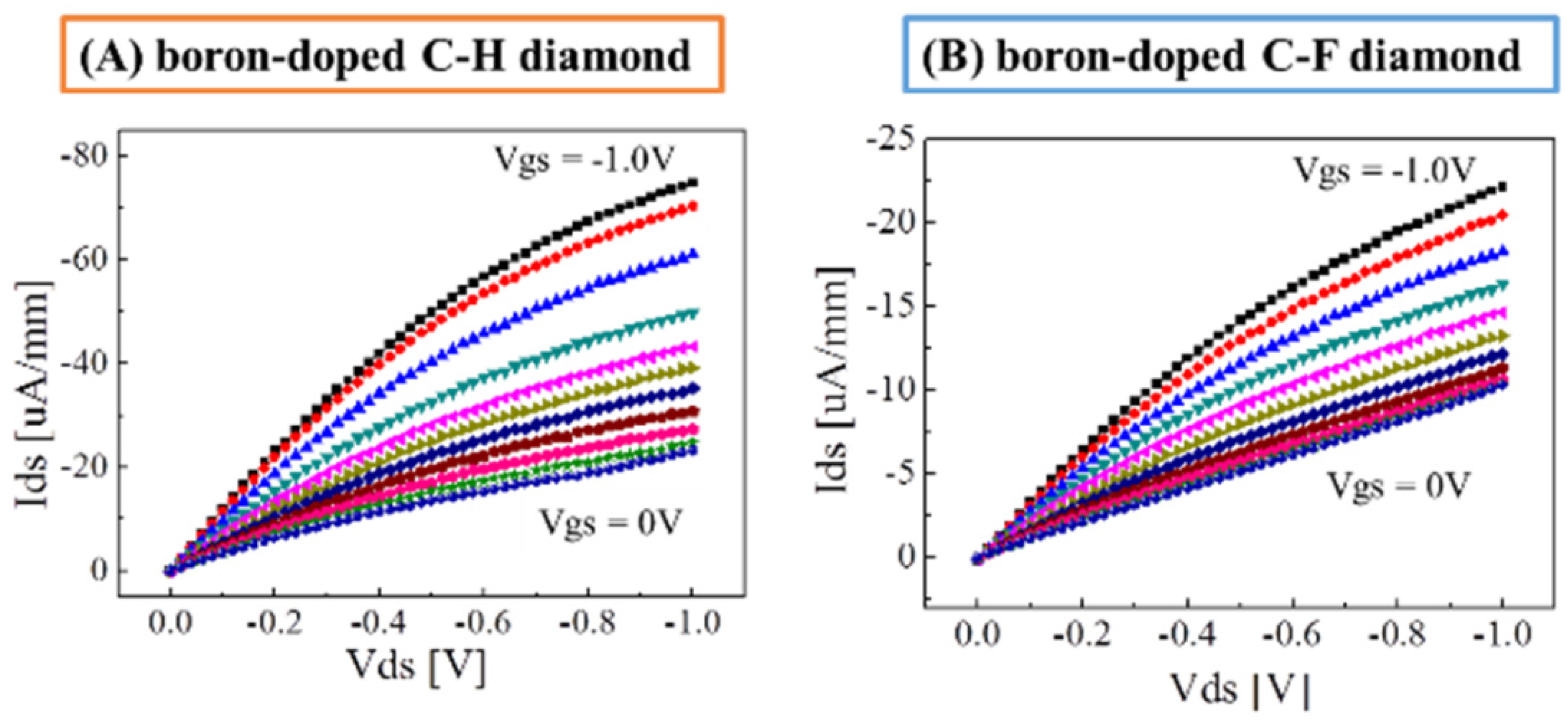
| Bonding Site | Binding Energy (eV) | Coverage (%) | |
|---|---|---|---|
| F2-Treated | C3F8-ICP-Treated | ||
| C–F3 | 292.8 | 2.2 | 10.8 |
| C–F2 | 290.9 | 5.5 | 17.1 |
| C–F | 288.8 | 9.9 | 9.7 |
| C–CF | 286.6 | 19.9 | 8.6 |
| C–C(sp3) | 285 | 62.4 | 53.9 |
Publisher’s Note: MDPI stays neutral with regard to jurisdictional claims in published maps and institutional affiliations. |
© 2022 by the authors. Licensee MDPI, Basel, Switzerland. This article is an open access article distributed under the terms and conditions of the Creative Commons Attribution (CC BY) license (https://creativecommons.org/licenses/by/4.0/).
Share and Cite
Shintani, Y.; Kawarada, H. Fluorine-Terminated Polycrystalline Diamond Solution-Gate Field-Effect Transistor Sensor with Smaller Amount of Unexpectedly Generated Fluorocarbon Film Fabricated by Fluorine Gas Treatment. Materials 2022, 15, 2966. https://doi.org/10.3390/ma15092966
Shintani Y, Kawarada H. Fluorine-Terminated Polycrystalline Diamond Solution-Gate Field-Effect Transistor Sensor with Smaller Amount of Unexpectedly Generated Fluorocarbon Film Fabricated by Fluorine Gas Treatment. Materials. 2022; 15(9):2966. https://doi.org/10.3390/ma15092966
Chicago/Turabian StyleShintani, Yukihiro, and Hiroshi Kawarada. 2022. "Fluorine-Terminated Polycrystalline Diamond Solution-Gate Field-Effect Transistor Sensor with Smaller Amount of Unexpectedly Generated Fluorocarbon Film Fabricated by Fluorine Gas Treatment" Materials 15, no. 9: 2966. https://doi.org/10.3390/ma15092966






